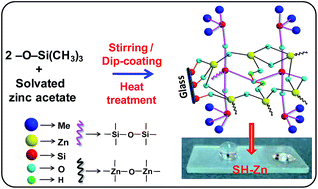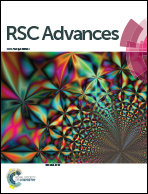Durable superhydrophobic ZnO–SiO2 films: a new approach to enhance the abrasion resistant property of trimethylsilyl functionalized SiO2 nanoparticles on glass†
Abstract
Although trimethylsilyl functionalized SiO2 derived films show excellent superhydrophobicity, their adhesion and abrasion resistant properties are extremely poor. In this study, a new approach has been shown to improve the adhesion and abrasion properties of such films. A neutral and relatively hydrophobic [Zn(CH3OO)2(H2O)2] complex solution has been used to interact with the superhydrophobic silica gel nanoparticle dispersion. After dip-coating, the composite sol yielded films of a zinc acetate/superhydrophobic silica composite network while the hydrophilic part (bonded water) associated with Zn helps in binding the hydroxyl groups (silanols) present on the glass surface. The composite films were heat-treated at 300–400 °C in a nitrogen atmosphere in order to obtain transparent and superhydrophobic ZnO–SiO2 nanocomposite films. The decomposition of zinc acetate formed ZnO nanocrystallites and remained attached with the hybrid silica matrix. These films showed excellent water repellency (water contact angle, CA ≈ 158 ± 7°; hysteresis ≈ 4°) with good adhesion and abrasion resistant properties. XRD, Raman and TEM studies confirm the existence of ZnO nanocrystallites in the composite films. Owing to the stability of hydrophobic methyl groups attached with silicon at relatively high temperature in a nitrogen atmosphere, these ZnO–SiO2 nanocomposite films remain superhydrophobic even after a heat-treatment at 400 °C.


 Please wait while we load your content...
Please wait while we load your content...